Kitchen aprons made of plastic: varieties, brands and tips for choosing
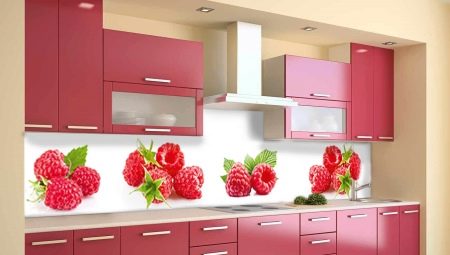
Kitchen apron - the area located above the sink, hob and countertop. For the design of this site, plastic is often chosen. Unlike most other options, plastic panels are inexpensive, come in a wide range of colors, and are easy to install yourself without the use of hired craftsmen.
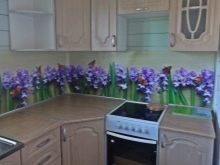
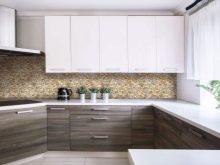
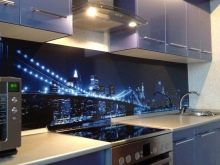
Peculiarities
A kitchen apron is constantly exposed to steam, moisture, grease splashes from cooking. That is why a number of requirements are imposed on it. He must:
- be resistant to temperature influences;
- do not deform at high humidity;
- easy to clean from various types of dirt;
- to be aesthetic, to be combined and in harmony with kitchen furnishings, decor and household appliances.
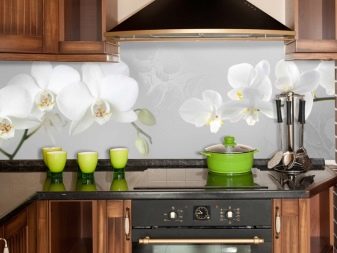
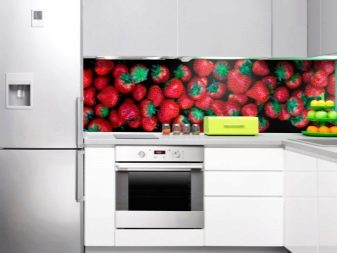
The vast majority of these requirements are met by a plastic kitchen apron. There are several types of such products. They are classified according to the material from which they are made. Wall panels are made of ABC-plastic, polycarbonate and PVC. They all have their own advantages and disadvantages, which should be considered in more detail.
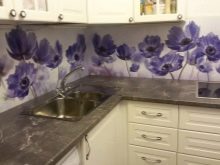
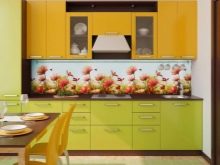
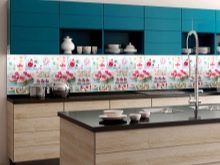
Advantages and disadvantages
When choosing plastic wall panels, you need to understand the features of each of their types. Plastic produced using various technologies has certain performance properties, different strength and service life.
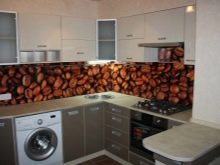
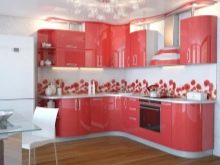
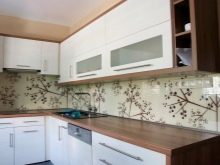
All this must be taken into account when choosing products.
PVC (polyvinyl chloride)
This type of plastic has the most affordable cost. Often, such a solution is chosen by people with a limited budget, and they are also preferred for decorating an apron in the country or in a rented apartment. The material is produced in the form of individual strips (lining) or wall panels of various sizes.
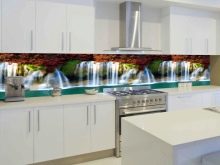
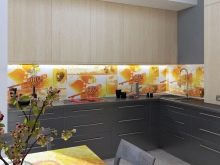
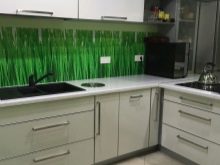
Products are produced in a wide range of colors and can imitate natural cladding.
Another important advantage of PVC panels is their easy installation. Installation is carried out on liquid nails, special adhesive or screws. The material is lightweight, thanks to which one person can cope with its installation.
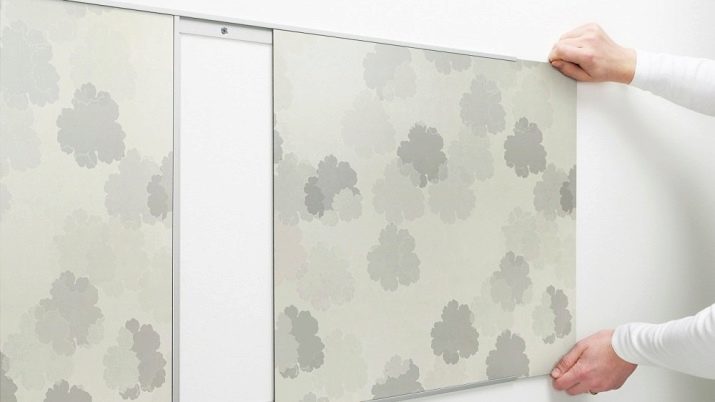
The fixing of the cladding is done quickly, and the installation itself does not require special knowledge or experience.
The disadvantages of PVC panels include:
- poor resistance to mechanical damage - one awkward movement, and the panel will easily break and require replacement;
- susceptibility to abrasion - during operation, scratches and scuffs will soon form on the apron, numerous consumer reviews confirm this fact;
- the appearance of yellowness and fading - all this happens when exposed to ultraviolet rays of the sun and with frequent cleaning using detergents;
- fragility - the products will not be able to serve for a long time, no matter how carefully they are handled.
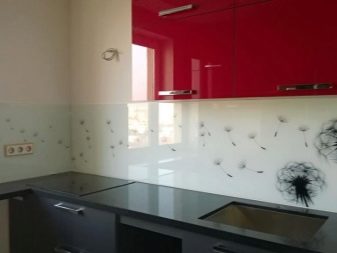
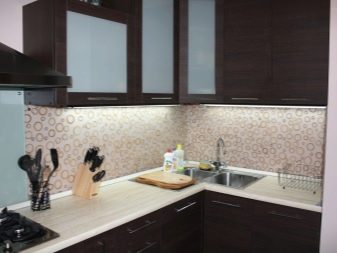
PVC panels have poor resistance to high temperatures - when it rises above 80 degrees, the panels are deformed and can ignite. If a low-quality plastic is selected, it will release toxic substances that are hazardous to health when melted. To reduce the risk of deformation of the cladding and its fire, you should choose other materials for decorating the area above the hob, for example, glass, ceramic tiles or mosaics.
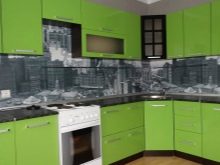
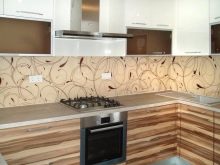
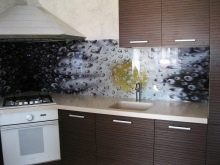
Polycarbonate (acrylic glass)
It is a material for the manufacture of which carbonic acid and phenol are used. There are two types of polycarbonate:
- cellular;
- monolithic.
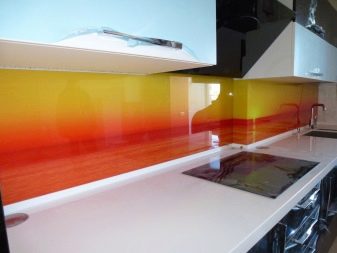
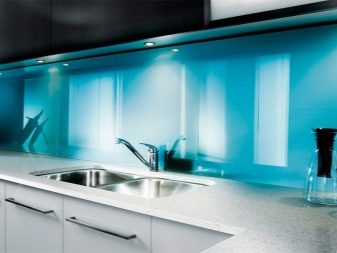
Externally, polycarbonate looks like silicate glass - it has a smooth and shiny surface. The material can be plain or decorated with photo printing. Advantages of a polycarbonate apron:
- excellent decorative qualities;
- resistance to power loads - the material is resistant to bending and is able to "withstand" even strong impacts;
- resistance to direct sunlight - the surface will not fade or tarnish;
- fire resistance - being close to incandescent objects, acrylic glass will not light up, but it may melt;
- easy installation.
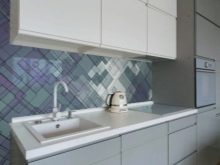

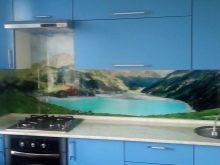
The polycarbonate cladding has some disadvantages. For example, high cost compared to other types of plastics. If we compare acrylic glass with ordinary glass surfaces or mosaics, then the latter will cost more. Another disadvantage is low abrasion resistance, which is why you should not use abrasive products when cleaning the apron.
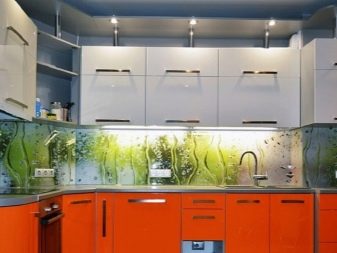
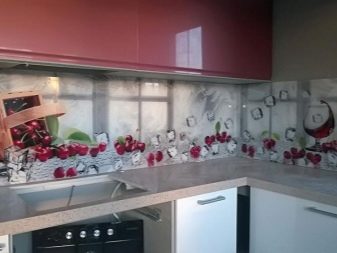
ABS plastic
It is a material made from acrylonitrite, butadiene and styrene. Products are lightweight sheets of various sizes. Such a cladding can be matte or glossy, have a metallized mirror layer.
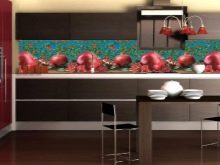
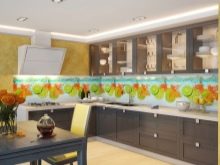
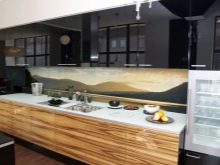
There are options with photo printing.
Advantages of ABS plastic:
- financial affordability - this material is cheaper than glass, MDF or ceramic tiles;
- impact resistance, bending strength;
- abrasion resistance;
- good flexibility, thanks to which the sheets can be easily fixed even on uneven walls;
- easy transportation - if necessary, the product can be rolled up and it will take up a minimum of space;
- easy DIY installation on liquid nails;
- easy cleaning - the panels can be washed with any detergents and cleaners;
- resistance to temperatures (up to 80 degrees);
- environmental friendliness.
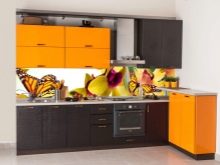
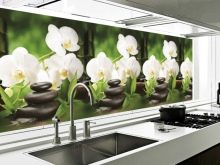
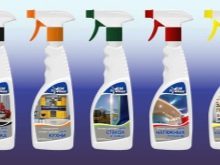
The disadvantages of ABS plastic include sunburn, "fear" of various solvents and acetone.
Image subject
Photo printing is often applied to plastic panels for an apron. Some companies are engaged in the manufacture of custom cladding - in this case, they are ready to satisfy all the consumer's requests regarding the applied picture.
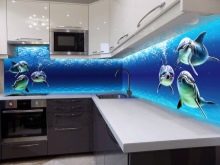
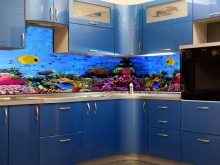
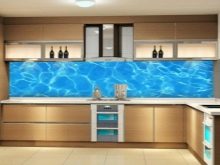
The choice of background theme is often based on the personal preferences of the buyer.
One of the most popular topics in the design of an apron is floristry. The panels can show off orchids, daisies, tulips, poppies, roses and various flower arrangements. In such drawings, there are often butterflies, birds, insects, there are products with the image of succulent grass. For any design of the working area, you can choose a color option - there are both bright drawings and images in more "calm" and delicate shades on sale.
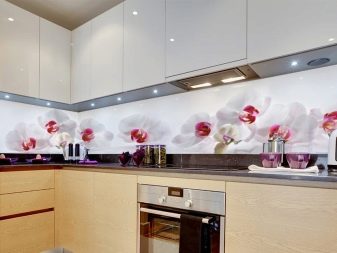
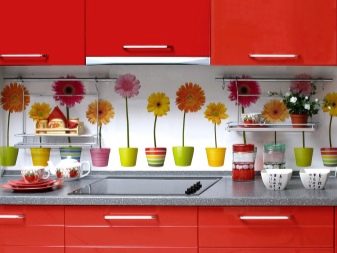
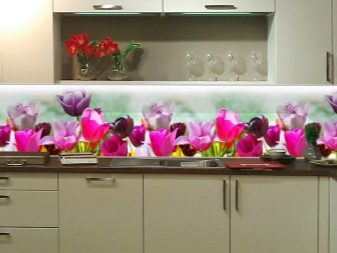
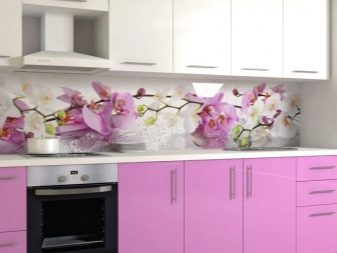
Another popular topic is fruits and berries. Citrus fruits look original and elegant close-up with dew drops on the surface of the peel. Often, the cladding depicts various fruit and berry compositions - such pictures will match any kitchen room.

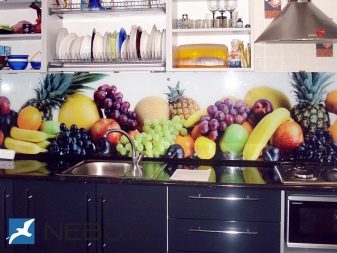
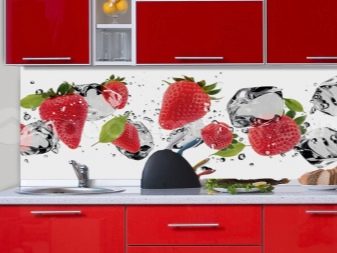
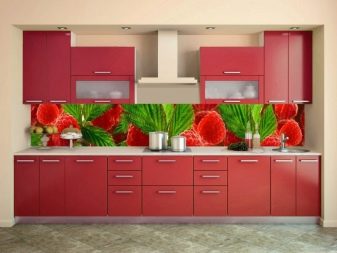
The subject matter is varied: nature, landscapes, still lifes, architectural structures, megacities, night cities are often depicted on the apron. Photo printing on aprons is a great opportunity to make your kitchen brighter and more attractive.
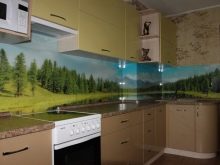
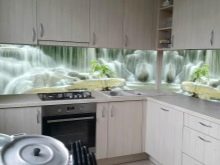
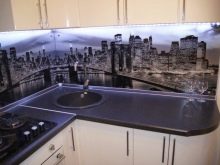
With the help of a properly selected image and color scheme, it is easy to visually expand a small room or focus the attention of households and guests on an elegant work area.
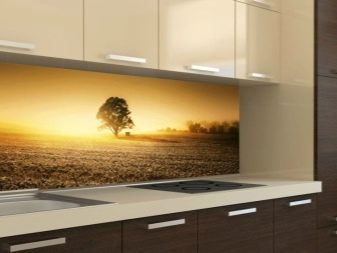

Color spectrum
A kitchen apron protects the surface of the walls from various types of dirt, and also serves as a decorative function. In order to successfully fit it into the interior of the room, it is important to choose the right color palette for the panels. If it is not planned to focus on the work area, monochromatic neutral colors are chosen. They can match the color of the kitchen itself, be transparent or lighter (darker) by 1-2 tones. These include white, gray, wet asphalt, beige and cream colors.
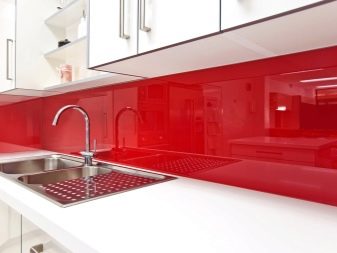

Aprons can also have bright colors. Plastic panels are:
- green;
- orange;
- red;
- blue;
- purple;
- pink;
- blue;
- burgundy;
- light green.
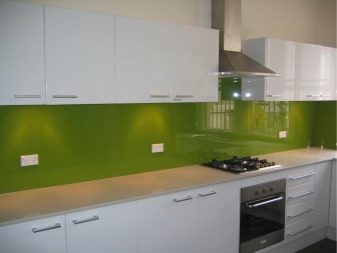
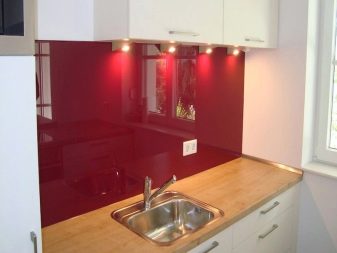
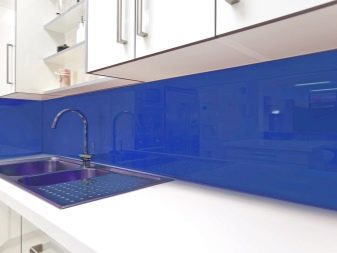
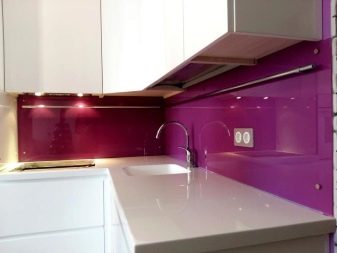
The bright color of the apron can be combined with the headset handles of the same color, decorative inserts on furniture, shelves, dishes and various decor and interior items. Sometimes people prefer dark colored aprons. It can be black, deep purple and deep blue. Such an apron will look stylish and elegant, but it is not suitable for every kitchen - if the headset is made mainly in dark colors, this area needs to be made light.
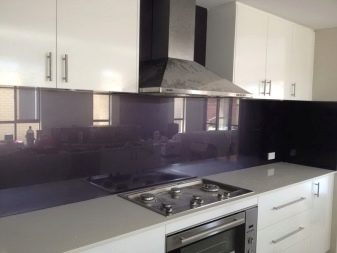
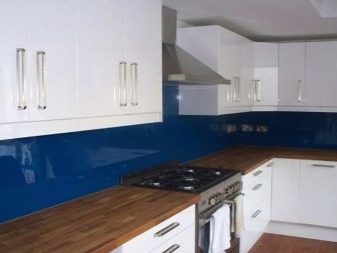
Design options
Thanks to plastic wall panels, you can embody a design idea of any complexity. These finishing products can have interesting texture solutions, a surface with a relief, be monochromatic or with an image applied using photo printing.
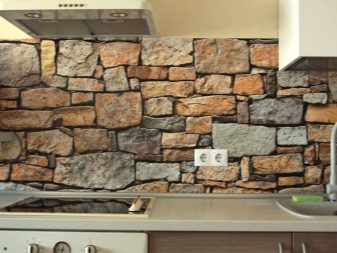
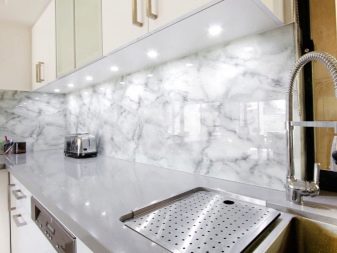
Recently, 3D plastic wall panels are gaining popularity. Interesting images can make any kitchen more original, interesting and exclusive. The subjects of such photographs can be mentally transferred to the forests, luxurious flowering gardens, to the sea, to the islands. The visually smooth and shiny panels are reminiscent of glass skins. However, the latter cannot be drilled in order to install rails or shelves. It is easy to make holes in plastic.

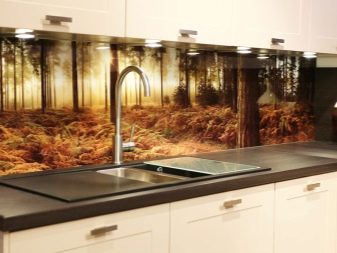
Plastic aprons imitating natural cladding do not reduce their popularity. Such panels can save not only money, but also the time spent on their installation. For example, laying bricks or tiles will require a lot of effort during installation, sometimes you even have to hire specialists to fix these materials.
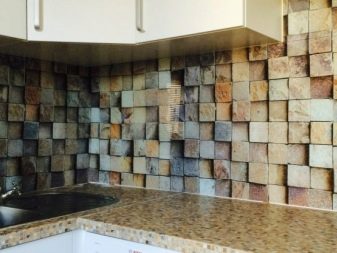
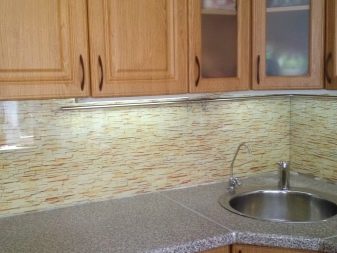
Plastic panels for tiles or bricks are easy to install with your own hands in a short time.
Decorative wall cladding can visually imitate ceramic hog tiles, artificial or natural stones, wood. Popular options are "under the tree" or under the "mosaic". A wide range of design solutions allows you to choose products for both classic styles and modern ones.
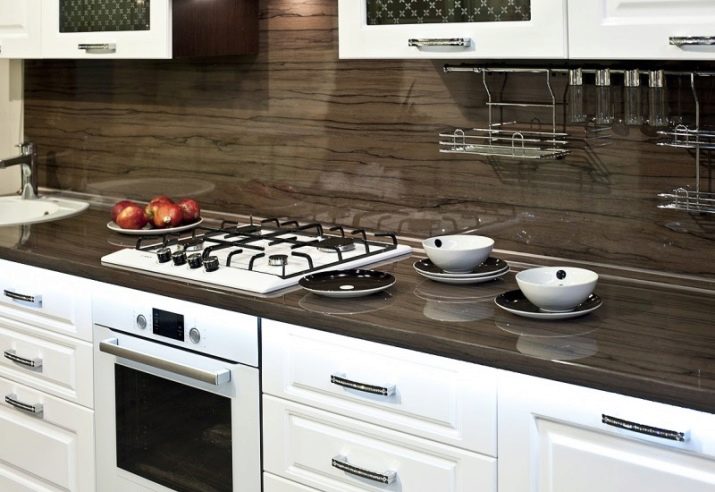
Manufacturers overview
On the Russian market, mainly plastic aprons of domestic production are sold. They are distinguished by their favorable cost and good quality. The following companies occupy the leading positions in production and sales.
- "Stolplit" Is a company founded in 1999. Its main activity is the production of home furniture. One of the largest companies in Russia producing wall panels using European equipment. Stolplit engineers are constantly looking for new solutions and offer consumers non-standard ideas for decorating the kitchen working area.
- Versailles Is a domestic manufacturer of plastic wall panels for kitchen apron cladding. It is engaged in the manufacture of products based on MDF boards. Offers a wide range of panels with flowers, cities, nature, abstraction, geometric patterns.
- "Palette". Russian manufacturer engaged in the manufacture of high-quality plastic panels with a glossy or matte surface. Most of the ready-made solutions are decorated with photo printing.
- "Century" - the company is engaged in the manufacture of plastic panels for the decoration of the apron area. Russian company offering a wide range of products for all types of kitchens in a wide price segment.
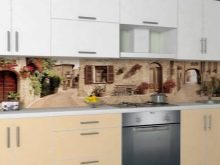

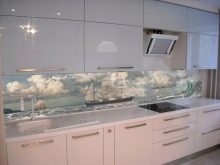
Most of Russian manufacturers use foreign equipment to apply photographic printing to wall panels. As a result, they manage to create striking cladding with unlimited design possibilities.
How to choose?
When looking at a plastic kitchen apron, it is important to make the right choice. To do this, you need to know a few nuances. It is best to refuse to buy PVC products - they are of poor quality and quickly deteriorate. Panels made of ABS plastic and polycarbonate are considered more reliable and durable.
- First of all, you need to inquire about the availability of relevant documentation: certificates of quality and fire safety of the material. These documents will help reduce the risk of purchasing low quality products.
- Price. The cost of products will depend on the manufacturer, the selected material and pattern. Experts recommend refusing to buy cheap products of dubious quality. Often, unscrupulous manufacturers use low-grade raw materials to reduce the cost of finished panels. As a result, such cladding can become hazardous to health or quickly lose its aesthetics.
- Design. Many people choose the pattern, tone and texture in accordance with personal preferences. However, there are several subtleties here. For a small kitchen, it is best to choose a light mirrored apron - it will visually expand the space. In addition, light-colored cladding is considered more practical, since hand marks or grease splashes will be almost invisible on it. On dark surfaces, such contamination is immediately apparent.
- Dimensions and thickness. The thicker the base of the panel and its decorative layer, the longer the cladding will last. The shape of the sheet is no less important - experts advise choosing solid elements that can cover the entire working area of the wall. The width and length of the products should be selected with a margin of 3-4 centimeters - this will allow the panels to run behind the kitchen cabinets and the table, ensuring the structure is hygienic. The most popular are products with a length of 3 meters.
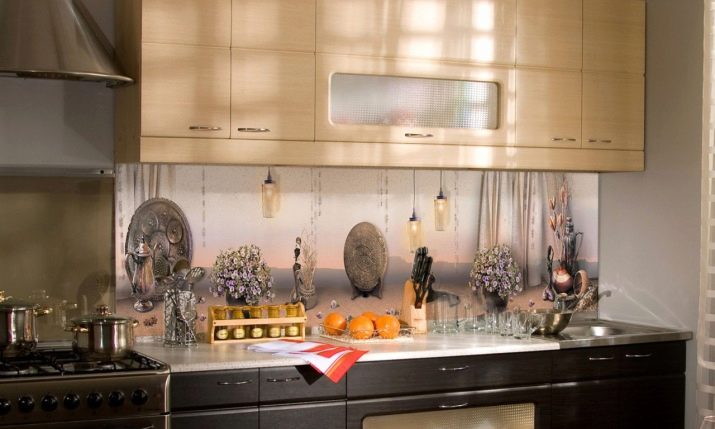
If the hostess likes to frequently change the interior of the kitchen, you can purchase a double-sided ABS plastic apron.It is fastened not to liquid nails, but to specialized wall profiles.
Beautiful examples
In order not to miscalculate with the interior of the kitchen, you should first familiarize yourself with the work of experienced craftsmen. The photos below clearly illustrate how with the help of wall panels you can create a beautiful apron and harmoniously fit it into the kitchen space.

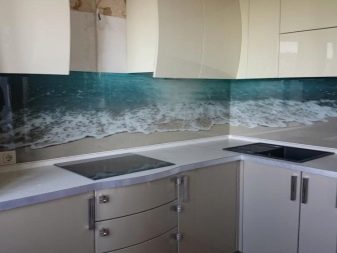
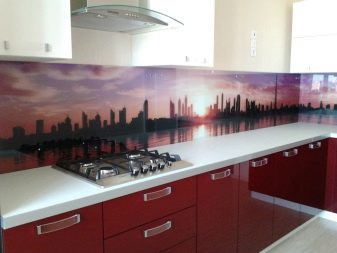
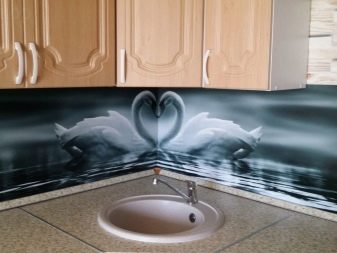
About plastic kitchen aprons in the video below.








